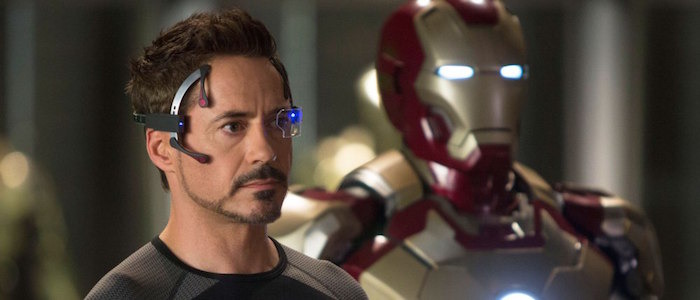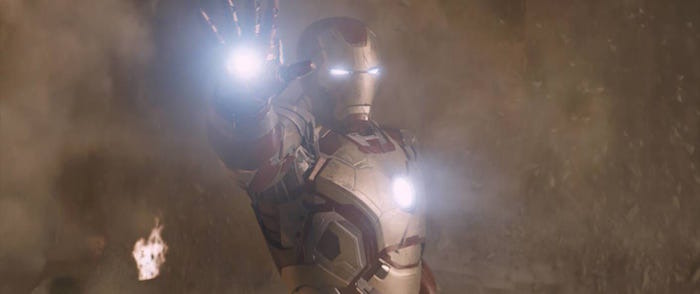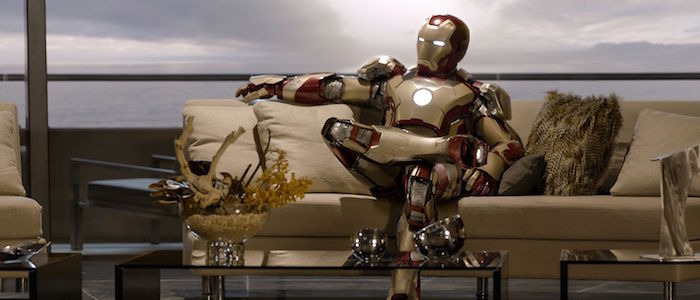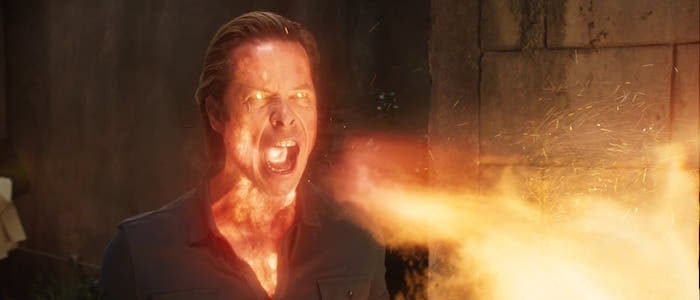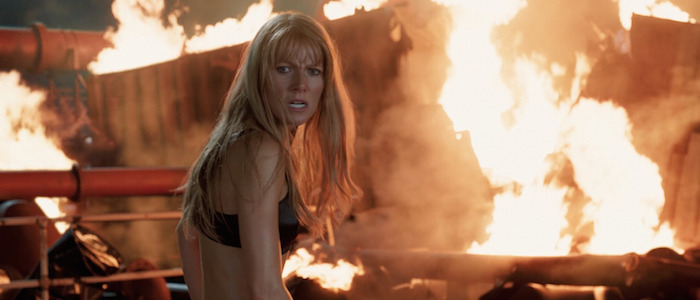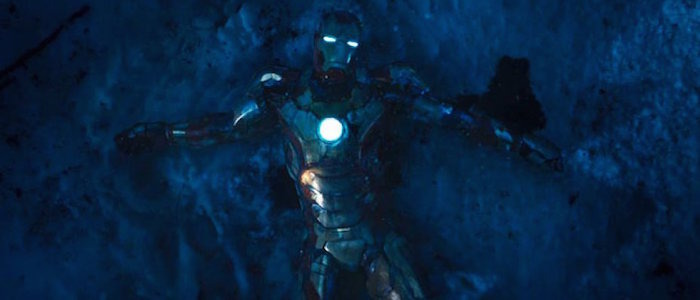Road To Endgame: How 'Iron Man 3' Forged A Unique Identity
(Welcome to Road to Endgame, where we revisit all 22 movies of the Marvel Cinematic Universe and ask, "How did we get here?" In this edition: Iron Man 3 brings a personal style to the MCU, even as it stumbles in the homestretch.)After six films culminating in an unprecedented crossover, the Marvel Cinematic Universe had arrived. The Avengers set a new standard for summer blockbusters, though the concern going forward (for skeptics, and presumably for studio execs) was one of diminishing returns. Iron Man's first solo outing after the battle of New York was tasked with bringing audiences back for more, while also establishing Marvel's ability to tell new kinds of stories. In effect, it had to dramatize moving on from the world of The Avengers, while taking place entirely within it.Simply put, the question Iron Man 3 had to answer was, "What comes next?" Would Marvel come close to rivaling the spectacle of its first team-up? Well, no. Then again, perhaps it didn't have to. Iron Man 3 is nothing like The Avengers. In fact, it barely has anything in common with Iron Man and Iron Man 2, though what it does have — despite yet another vaguely defined character arc — is something only a handful of Marvel movies can boast.It has a unique sense of identity.
Black to Basics
Outside the odd oblique tilt in Thor (and some self-contained, silent drama in The Incredible Hulk), Captain America: The First Avenger was arguably the only "Phase 1" film to sidestep the genre's visual trappings. You can thank Joe Johnston of The Rocketeer for that, but not every Marvel movie has the luxury of a period-adventure sandbox.Even The Avengers, which delivered some of the finest blockbuster spectacle this decade, didn't make particularly great use of visual storytelling until its final battle. Its major third-act beats worked because they translated character into action; for instance, the fluid long-take where the Avengers fight in tandem for the first time. One of its only non-action scenes, where subtext was expressed visually — Captain America's silent stroll through an unfamiliar world — was cut from the film.For the most part, Marvel movies rely on straightforward dialogue to deliver emotional information. Iron Man 3 however, feels like the first entry in the series where the filmmakers were granted visual leeway. For once, the end result was not, as critic Matt Zoller Seitz puts it, a "movie-flavored product."Despite the studio notes it was forced to adhere to (like swapping its female villain for a male one to sell more toys), Iron Man 3 is a Shane Black film through-and-through. Its tonal consistency is entirely a function of its story. Black often sets his films around Christmas because he feels the holiday "represents a little stutter in the march of days, a hush in which we have a chance to assess and retrospect our lives." When Christmas arrives for Tony Stark (Robert Downey Jr.), he's alone in a remote Tennessee locale, far flung from Happy Hogan (Jon Favreau) and Pepper Potts (Gwyneth Paltrow), the loved ones he put in danger.Stark's story began with him building armour to escape a remote cave. Here, for the first time in the series, he's forced to find a way out of his isolation without the help of his suits. The stage is set for Stark to reflect on his decisions, and on his post-Avengers identity as it relates to the Iron Man persona. The film doesn't quite stick the landing when it comes to these themes, but it finds an exciting momentum in the way it articulates them.Black and cinematographer John Toll (The Thin Red Line, Cloud Atlas) depart from the bright palette of The Avengers to deliver a darker entry, both visually and emotionally. The entire film feels frigid even before Stark gets stuck in the snow. Cold lighting defines the texture of each space, and the muted tones of the productions design are interrupted only by deep-red explosions. The film is drab without being dour, and the characters constantly have to fight their way out of shadows.In several scenes, the camera observes instead of empathizing. We see Pepper Potts' meeting with Aldrich Killian (Guy Pearce) through Happy Hogan's eyes, as he sits in the distance, relaying the information to Stark over the phone. Black, like Hogan, is people-watching, and the visual framing constantly prevents Stark from connecting with those around him. After Stark's home is attacked, he's forcefully ejected from his own narrative and launched thousands of miles away. Physically, and emotionally, he could not be more distant.The fluid cinematography, combined with the fluidity of Black's action and dialogue (the script was co-written by Drew Pearce) gives Iron Man 3 a distinctly "cinematic" texture — that is to say, one heavily reliant on non-dialogue audio and visuals to convey meaning — the kind few Marvel films can claim. Downey Jr. underscores the affair with his dry wit as usual, and his emotional separation becomes necessary so that Iron Man can (re)define himself in relation to other people.Despite the distancing quality of the group scenes, the film extends beyond observational exercise at just the right moments. Its point-of-view shifts jarringly when Stark's P.T.S.D. comes to the fore. The frame closes in on him with furor, until all we can see, or feel, is panic. Iron Man 3 is at its most potent when exploring the psychological effects of The Avengers on Stark, though unfortunately, there also comes a point when this vital story thread is haphazardly brushed aside.
Nothing’s Been the Same Since New York
Tony Stark was once known as Marvel's alcoholic superhero — Demon in a Bottle (1979) is his most instrumental story — and while the character's alcoholism never finds its way into the films, Stark's addict nature manifests in different forms. In Iron Man 3, his addiction is to building protective armour, and it's exacerbated by trauma.Clinical psychologist Dr. Andrea Letamendi argues that Stark's symptoms could, in fact, be interpreted as Post-traumatic stress disorder, or P.T.S.D. He seems to display four key factors for diagnosis:
More pertinently, Tony Stark is also more vulnerable to P.T.S.D. than the average human being, owing to what Letamendi calls "re-deployment." Stark has been experiencing and re-experiencing trauma since the very first scene in Iron Man. His car was bombed, he had shrapnel lodged in his chest, he was kidnapped and tortured, and he spent the rest of the series embroiled in violent conflict. The Iron Man armour is as much an addiction as it is a symptom, not unlike P.T.S.D.-afflicted soldiers sleeping with guns by their bedside (Stark even calls to one of his suits in his sleep).There are now 42 versions of the Iron Man armour, each created for different contingencies. The 42nd, which Stark operates remotely from his workspace, has even begun to replace him in his interactions with Potts. He's frozen in the moment he flew through the wormhole above New York City, and his technology has consumed him,The film dramatizes Stark's symptoms with aplomb. The leering, distant camera is traded in for rapid zooms and uncomfortable close ups when his anxiety rears its head. The visual shifts feel inescapable; the lens becomes another wall closing in on Stark as we, the audience, poke and prod into his psyche, intruding on both his personal space and his most traumatic memories.Stark's experiences in The Avengers are collectively referred to as "New York." This, coupled with his vengeful, self-destructive attitude towards vaguely Middle Eastern terrorist The Mandarin (Ben Kingsley) calls to mind America's own post-9/11 political tenor — albeit to no real end, despite the potential for exploring wartime paranoia.However, Stark's specific road to recovery makes Iron Man 3 a noteworthy sequel. In the context of Marvel's shared-universe, his arc in this film involves letting go of his own origin story, and his journey to doing so means moving past the events of The Avengers. As much as Iron Man 3 is about defining Iron Man outside of his suits, it's also about defining this larger narrative outside its most recognizable moments.
Separation
The film begins the process of separating Stark from the larger saga by introducing antagonists independent of previous Marvel films. The explosive Extremis Soldiers seem to simply exist, with no connections to Gamma Radiation, the Super Soldier Serum or Stark's technology, something only Loki has had the distinction of thus far. Stark even searches for connections to prior entries, but it turns out the soldiers were created by Aldrich Killian, whose path to Extremis began decade before The Avengers. It's as if Stark must move past the memory of his crossover and confront something new, just to make this movie happen.Unfortunately, this meta-narrative of blazing a new path takes precedence over Stark's mindset, the backbone of the film. His story is set up admirably, before being promptly forgotten.Stark is in a bad way. He can't sleep. His anxiety is triggered by a child's drawing of the event — a crayon depiction of him flying towards the source of his trauma — leading to a public breakdown. He's even triggered by Harley Keener (Ty Simpkins) simply mentioning New York, and it gets to a point where he has a mid-freeway episode for almost no reason at all.With his suits out of commission, Stark attempts to combat his disorder by building weapons out of hardware scraps. Creating new tech to protect himself, a one-time survival mechanism in Iron Man, has become his crutch. Though while he finally sheds his stockpile by the end of the film, his journey to doing so feels disconnected. The freeway freak-out is the last time his anxiety or P.T.S.D. come up in the narrative.What follows is a passable display of the film trying to figure out who Stark is outside of his iron cocoon. Fighting with only one Iron Man boot and glove makes for a hilarious action beat, but the film's climactic scenes are muddled, especially in how they try to define Stark in relation to his new villain.Like Thor before it, Iron Man 3 is yet another example of a Marvel film being "almost there" with its character arc.
A Clash of Ideologies, or Lack Thereof
There's much debate as to the movie version of The Mandarin (Ben Kingsley), originally a racist caricature best left in the '60s. The character being cast Indian rather than Chinese avoids outright whitewashing, though the form he takes instead of an orientalist stereotype is an intentional mixture of bastardized iconographies — see also, his Captain America tattoo which uses an Anarchist 'A'.Not unlike real-world terrorist outfits (ISIL, for one), the Mandarin lays claim to attacks that may not be his doing. He likens the recently-bombed Hollywood's Chinese Theatre to the fortune cookie, an American-in-origin manipulation of Eastern imagery, repackaged and mass-marketed to the West. Fittingly, this ideological repackaging is exactly who the Mandarin is too.As revealed late in the film, the Mandarin is actually a hodgepodge of western fears, a think-tank terrorist strung together by a clueless actor and his wealthy benefactor, Aldrich Killian. It's a believable explanation for Killian's unstable-to-the-point-of-explosion Extremis Soldiers, thus avoiding further inquiry into his experiments. This Mandarin borrows the symbol of The Ten Rings, the organization that kidnapped Tony Stark in Iron Man, and he fashions himself (or rather, is fashioned by Killian) as a grandiose, moralizing zealot, hell-bent on attacking the United States and its foreign interests.For the first time, the Marvel Cinematic Universe comes this close to having something concrete to say about America. The "war on terror" being nebulous here, as it's often framed the real world, allows Killian to sell biological weapons to both sides. These "both sides," however, are never defined, or even alluded to in any way that would flesh out Killian and the world around him. Who Killian sells to matters, because his willingness to sell to them ultimately defines his conscience.Credit where credit is due: compared to the other films in the series, Iron Man 3 features a marginally more critical take on America's military industrial complex, certainly more than Iron Man, Iron Man 2, Captain America: The Winter Soldier and Captain Marvel, which were all made with military funding. And while Iron Man 3 cast several real-life Air Force recruits, there's yet to be any evidence of Department of Defense involvement in the film.Rather than avoiding the question of military ideology altogether, Iron Man 3 frames capitalist war profiteering through its sheer lack of ideology outside of money and power, something even U.S. political biopics have started to do. Though, the profit-motive being divorced from concerns of who, culturally or racially, is considered expendable, is its own relevant issue, something even the most military-centric Marvel films barely touch on.Over the course of the film, U.S. militarism is sold and packaged through media narratives on multiple fronts. One on hand, there are televised portrayals of vaguely Middle Eastern threats, whose outlook is irrelevant so long as they seem scary to Americans. On the other, the film shows America's limp, lip-service-only ideological response to those threats, as the nation simply paints over the heavily armed "War Machine" (Don Cheadle) in red, white & blue and calls him "The Iron Patriot" (War crimes often become acceptable when given focus-tested monikers).While the film does little to portray the actual effects of this warmongering (Iron Patriot's foreign interventions play out as dark comedy), it does portray the American response as both predictable and ill-considered. Killian takes advantage of this, conning the American President into invading Pakistan on two different occasions as the villain sets his traps elsewhere. While Iron Man and Iron Man 2 blame military industrialism solely on industry, Iron Man 3 at least draws a line straight to the U.S. Commander-In-Chief; the bare minimum, in a series so focused on war.The downside to this empty ideology, as is the case in prior Marvel films, is that it fails to properly mirror the character-story being told. Aldrich Killian's motivations are disconnected from Stark's "self-created demons." Killian has an unfeeling dedication to the business of war (as Stark once did), but his appearance in Stark's flashback does little to entwine the two beyond happenstance. Where Killian would have fit perfectly in prior Iron Man entries, Iron Man 3 isn't concerned with Stark's place in the world of warfare.Killian's ruthlessness is on full display after the Mandarin reveal. He treats his soldiers as disposable, and he readily murders Maya Hansen (Rebecca Hall), the one person whose objectives are aligned with his. He doesn't care about the people closest to him, which is what separates him from Stark on the surface. Stark's arc, at least nominally, involves learning that Happy Hogan, Pepper Potts and the likes ought to be more important to him than his suits. This journey is externalized when Potts seemingly dies, followed by Stark's far-too-late realization of just how good he had it.However this dramatic beat, while functional as a self-contained moment, is entirely detached from Stark's larger story, a narrative disconnect that's only exacerbated by the specifics of the climax.
Fireworks in Lieu of Character
Tony Stark shedding his armour at the end of the film makes sense on paper. The Iron Man concept has become an anchor, and Stark's ultimate test ought to be whether or not he's able function without it. Yet the film's third act, an action-laden set-piece featured heavily in the trailers, sees him entirely reliant on his technology once more.Summoning dozens of Iron Man suits is cool. Each one having a different design is cool, despite primarily existing to sell toys. The remote centralization of these unmanned drones is... well, it's dangerous, but it looks cool, and the image of Stark jumping from suit to suit is cool as well. Ultimately though, empty suits fighting anonymous henchmen is still an empty spectacle, and it happens to be at odds with Stark's journey in the film.Stark's reliance on his technology is never put to the test; if anything, the finale only supports his obsession. His addiction to his suits is as much a psychological phenomenon that defines his character, as it is a dramatic want or desire in the mechanics of the story. Destroying his outlet (or symptom) neither helps him confront the roots of his trauma, nor adequately pays off the conflict between both needing his suits, and needing to destroy them in order to exist completely. As fun as Iron Man 3 may be, discarding its P.T.S.D. thread this way is narratively disingenuous.
The Road Ahead
By this point in the franchise, Robert Downey Jr. had become Marvel's not-so-secret weapon, and Iron Man 3 features some of the best dramatic work of his career. He's allowed to dig deep into what makes Stark tick (and what prevents him from ticking), working in tandem with Black's signature sarcasm-as-shield while balancing it with unshielded moments of vulnerability. Even when the spinning plates prove too many for the story, Downey Jr. balances them with finesse, which is part of why the film feels coherent despite dropping the ball thematically.In the film's closing narration, Stark utters two key phrases: "I'm a changed man" and "I am Iron Man." The former mirrors a mal-formed character moment in Thor — the God of Thunder says, "I've changed," though it isn't clear how — while the latter is an intentional callback to the first Iron Man. These sentiments are distinctly at odds with one another, and their conflict is never reckoned with until later in the series.Stark hasn't given up being Iron Man, mind you; it would be unrealistic to expect him to, in a series so lucrative, even though it would've made for a stronger character arc; as video essayist Patrick Willems points out, Marvel's "Phase 2" is where the series begins exhibiting the illusion of change. The removal of the reactor in Stark's chest indicates that he no longer cocoons himself in armour, but the "change" in question doesn't come from no longer needing his suits. Nothing is truly different about Tony Stark between the beginning and the end of the film; at some point, his disorder simply fades. His decision to destroy his suits seems to come from wanting to no longer need them, for Potts' sake. However, the recognition that change can or ought to happen is vastly different from actual change. The latter is where stories end. The former is usually where they begin.It's an unsatisfying narrative conclusion to a story about the personal effects of trauma. But like its predecessors, Iron Man 3 also inadvertently sets into motion specific narrative faults that are eventually taken advantage of, in ways that alter the series' approach to Tony Stark. If there's one thing Marvel is good at, it's taking flaws in narrative framing and retroactively weaving them into the text; the political short-sightedness of Iron Man and Iron Man 2 went on to become Stark's political blinders; the inadequate character change in Iron Man 3 became a defining trait.Iron Man 3 felt like the third time the reset button had been pushed on Tony Stark. His mistakes remained unconfronted, and his story merely had the appearance of progress. But by turning this dramatic shortcoming into an inter-textual narrative, the Marvel Cinematic Universe turned another weakness into a new foundation. From this point on, Stark's backbone was his penchant for combating mistakes with even more mistakes, creating a long-running narrative between films like Avengers: Age of Ultron, Captain America: Civil War, and even Spider-Man: Homecoming, culminating in Stark's ultimate failure in Avengers: Infinity War.Marvel's shared-universe has succeeded because of its long-term story. Not one of Infinity Stones and Quantum Realms and other cosmic plots, but one rooted in characters like Tony Stark. The MCU's heroes are why the series works, despite its myriad of other flaws. If anything, Marvel's sleight-of-hand makes those flaws seem like they were the plan all along.
***
Expanded from an article published April 10 2018.

